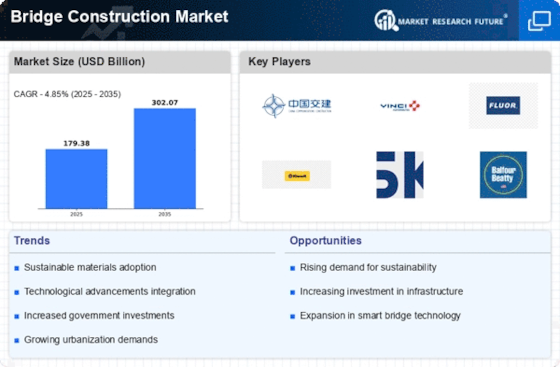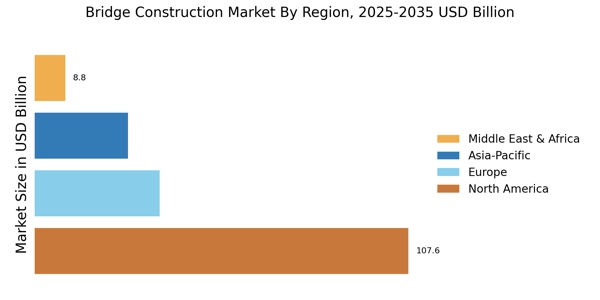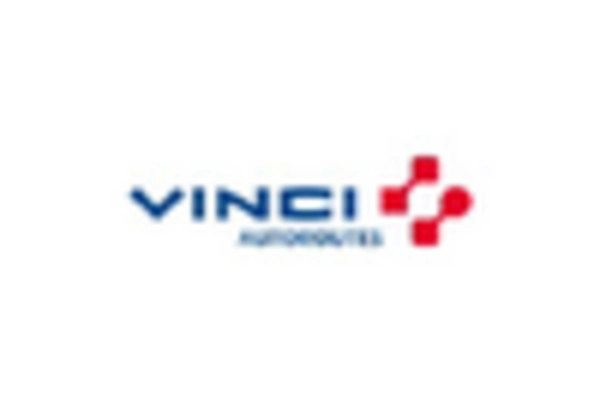Urbanization and Population Growth
The ongoing trend of urbanization and population growth is exerting considerable pressure on existing infrastructure, thereby propelling the Bridge Construction Market. As cities expand and populations increase, the demand for efficient transportation networks becomes more pronounced. This necessitates the construction of new bridges to alleviate congestion and improve connectivity. Recent statistics suggest that urban areas are projected to house nearly 70% of the world's population by 2050, which underscores the urgency for infrastructure development. Consequently, governments and private sectors are prioritizing bridge construction projects to meet these demands. This trend not only stimulates economic activity but also creates job opportunities within the construction sector. The Bridge Construction Market is thus positioned to benefit from this demographic shift, as investments in infrastructure become a focal point for urban planners and policymakers.
Increased Investment in Infrastructure
The Bridge Construction Market is currently experiencing a surge in investment, driven by the need for improved infrastructure. Governments and private entities are allocating substantial budgets to enhance transportation networks, which includes the construction of new bridges and the rehabilitation of existing ones. For instance, recent reports indicate that infrastructure spending is projected to reach trillions of dollars over the next decade, with a significant portion earmarked for bridge projects. This influx of capital is likely to stimulate growth within the Bridge Construction Market, as it creates opportunities for contractors, engineers, and suppliers. Furthermore, the emphasis on modernizing aging infrastructure is expected to lead to innovative construction techniques and materials, thereby enhancing the overall efficiency and safety of bridge construction.
Rising Demand for Sustainable Solutions
Sustainability has emerged as a pivotal driver in the Bridge Construction Market. As environmental concerns gain prominence, there is a growing demand for eco-friendly construction practices. This trend is reflected in the increasing adoption of sustainable materials and technologies, such as recycled steel and green concrete, which minimize the ecological footprint of bridge projects. Additionally, regulatory frameworks are evolving to encourage sustainable practices, further influencing market dynamics. The integration of renewable energy sources, such as solar panels on bridge structures, is also gaining traction. This shift towards sustainability not only addresses environmental challenges but also appeals to stakeholders who prioritize corporate social responsibility. Consequently, the Bridge Construction Market is likely to witness a transformation as it aligns with these sustainability goals.
Technological Advancements in Construction
Technological innovation is reshaping the Bridge Construction Market, introducing new methodologies and tools that enhance efficiency and safety. The adoption of advanced technologies, such as Building Information Modeling (BIM), drones, and 3D printing, is revolutionizing the way bridges are designed and constructed. These technologies facilitate better project management, reduce construction time, and improve accuracy in design and execution. For example, the use of drones for site surveys allows for real-time data collection, which can significantly streamline the planning process. Moreover, the integration of smart technologies into bridge design, such as sensors for monitoring structural health, is becoming increasingly common. This trend not only enhances the longevity of bridges but also ensures safety for users. As these technological advancements continue to evolve, they are expected to play a crucial role in driving growth within the Bridge Construction Market.
Government Policies and Funding Initiatives
Government policies and funding initiatives are critical drivers of the Bridge Construction Market. Various governments are implementing strategic plans to enhance infrastructure, which includes substantial funding for bridge construction projects. These initiatives often aim to address safety concerns, improve transportation efficiency, and stimulate economic growth. For instance, infrastructure bills and grants are being introduced to support the development of new bridges and the maintenance of existing ones. Additionally, public-private partnerships are becoming increasingly common, allowing for shared investment in large-scale bridge projects. This collaborative approach not only mitigates financial risks but also accelerates project timelines. As a result, the Bridge Construction Market is likely to experience robust growth, fueled by favorable government policies and increased funding opportunities.


















Leave a Comment